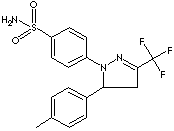PRODUCT IDENTIFICATION

H.S. CODE
TOXICITY
SMILES
CLASSIFICATION
EXTRA NOTES
Celecoxib is a non-steroidal, anti-inflammatory drug (NSAID) and a cyclooxygenase-2 (COX-2) selective inhibitor. Celecoxib is at least 10-20 times more selective for COX-2 over COX-1.
PHYSICAL AND CHEMICAL PROPERTIES
AUTOIGNITION
NFPA RATINGS
REFRACTIVE INDEX
Stable under ordinary conditions
EXTERNAL LINKS & GENERAL DESCRIPTION
Drug Information Portal (U.S. National Library of Medicine) - Celecoxib
http://www.latamjpharm.org/
Celecoxib
Identification Methods - Celecoxib is a nonsteroidal anti-inflammatory
drug used in the treatment of pain and inflammation, associated
with rheumatoid arthritis, and several other inflammatory disorders.
The objective of this study was the identification of celecoxib
through several analytical methods. Celecoxib was identified by
its melting range, ultraviolet and infrared spectrophotometry, thin
layer chromatography, and nuclear magnetic resonance, all of them
performed in accordance with the methodologies of the official codes.
The methods used have been found to be fast, efficient, reproducible
and are suitable for the identification of celecoxib.
Local:
Celecoxib, a
diaryl substituted pyrazole, is a nonsteroidal antiinflammatory drug
used for the symptomatic treatment of osteoarthritis and rheumatoid arthritis.
It is an inhibitor of cyclooxygenase-2 and oxidoreductase. The chemical
designation is 4-[5-(4-methylphenyl)-3- (trifluoromethyl)-1H- pyrazol-1-yl]
benzenesulfonamide. It is a white powder; insoluble in water; soluble in
methanol and chloroform; melting point 157-158 C; administered orally.
Nonsteroidal Antiinflammatory Drugs (NSAIDs); chemically heterogeneous large groups of drugs which suppress inflammation in a manner similar to steroids, but less side effects of sedation, respiratory depression, or addiction than steroids. They are widely used for the treatment of inflammatory disorders and painful conditions such as rheumatoid arthritis, gout, bursitis, painful menstruation, and headache. They are effective in the relief of pain and fever. NSAIDs inhibit the cyclooxygenase (COX) activity resulting in decreased synthesis of prostaglandin, leukotriene and thromboxane precursors such as the ubiquitous enzyme which catalyzes the initial step in the synthesis of prostanoids. Prostanoid is any of a group of C-20 fatty acids complex with an internal five or six carbon rings such as prostaglandins, prostanoic acid, prostacyclins, and thromboxane; derived from arachidonic acid (C-20 polyunsaturated fatty acid with four cis double bonds). The action or the synthesis of prostanoids are involved in the modulation of a variety of pathophysiologic processes including inflammation, hemostasis, thrombosis, cytoprotection, ulceration, hemodynamics and other the progression of kidney diseases. Thus, NSAIDs as non-selective inhibitors of the cyclooxygenases (both the cyclooxygenase-1 and cyclooxygenase-2 isoenzymes) may have beneficial as well as untoward effects on a variety of human diseases. Low stomach prostanoid levels caused by COX-1 inhibitors can result in ulceration and internal bleeding and perforation. The selective COX-2 inhibitors such as oxicam, meloxicam, and coxibs (celecoxib, rofecoxib, valdecoxib, parecoxib and etoricoxib) do not interfere with COX-1. The most prominent NSAID is aspirin. Nonaspirin NSAIDs can be classified based on chemical structures.
Nonsteroidal Anti-Inflammatory Drugs (NSAID) by chemical structure
- Carboxylic Acid Groups
- Salicylates (Acetylsalicylate, Choline salicylate, Diflunisal, Magnesium choline salicylate, Magnesium salicylate, Salsalate)
- Acetic Acids (Bendazac, Diclofenac, Etodolac, Indomethacin, Ketorolac, Nabumetone, Sulindac, Tolmetin)
- Propionic acids (Carprofen, Fenoprofen, Flurbiprofen, Ibuprofen, Ketoprofen, Loxoprofen, Naproxen, Naproxen sodium, Oxaprozin, Vedaprofen)
- Anthranilic acids (Meclofenamic acid, Meclofenamate sodium, Tolfenamic acid)
- Phenylacetic acids
- Aminonicotinic acids (Flunixin)
- Indole Analogs (Indomethacin, Nabumetone, Ketorolac, Etodolac,)
- Enolic Acid Groups (which doesn't have carboxylic group but acid due to the enolic hydroxy substituent)
- Pyrazolones (Phenylbutazone, Oxyphenbutazone, Dipyrone, Ramifenazone)
- Oxicams (Meloxicam, Piroxicam, Tenoxicam)
- Coxibs
- Celecoxib, Rofecoxib, Valdecoxib, Parecoxib, Etoricoxib
- Gold Salts
- Auranofin, Gold sodium thiomalate, Aurothioglucose
APPEARANCE
IDENTIFICATION
Complies Test A,B
ASSAY
98.0 - 102.0% (HPLC)
IMPURITY
0.5% max
SULFATED ASH
0.005% max
HEAVY METALS
10ppm max
WATER
0.5% max